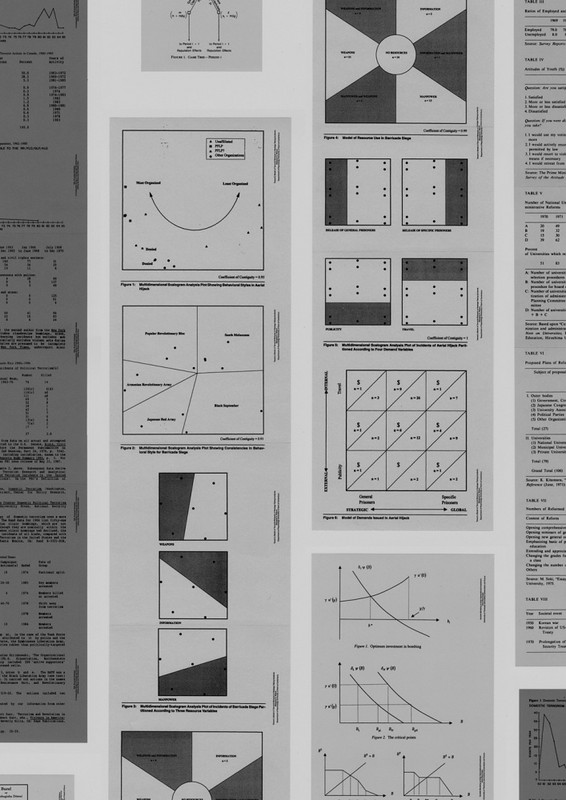Eric Baudelaire
23 Nov 2014 - 22 Feb 2015
ERIC BAUDELAIRE
Frmawreok Famrewrok Frmaeowrk Fomarerwk
23 November 2014 – 22 February 2015
Curated by Nina Tabassomi
The films, photographs and installations by Eric Baudelaire (born 1973) investigate the very framing conditions of historiographical narration. How do the production processes underlying a film image, a story, a portrait or a document themselves shape the reality they depict? By mobilizing and using the hidden framework of media devices, templates and ideologies with which we construct history, present and future and in staging them within the frame, Baudelaire creates fictitious documentary and documentary fiction. Here, a document turns into a framed picture, a film improvisation collides with the exhibited film script, a documentary film portrayal does not show portrait images of those portrayed, an analytical diagram becomes an ornament on a wallpaper.
Baudelaire’s first institutional solo exhibition in Germany presents three chapters of works dealing with the relationship between the Japanese New Wave cinema movement and the Japanese Red Army, between Tokyo and Beirut, revolutionary filmmaking and terrorist armed struggle. In collaboration with Masao Adachi, who was a key figure of Japanese avant-garde filmmaking and an ideologue in the Japanese Red Army, Baudelaire realised two films exploring the interconnections of militant politics and aesthetics: The Anabasis of May and Fusako Shigenobu, Masao Adachi and 27 Years Without Images (2011) and The Ugly One (2013).
With FRMAWREOK FAMREWROK FRMAEOWRK FOMARERWK, Baudelaire has produced a new chapter to these recent works and their installation, a layer that brings into the literal foreground the origins of his interest in these issues. Having trained as a political scientist, Baudelaire reveals, on over 200 meters of wallpaper, his vast collection of figures and tables that social scientists fabricate to grasp the elusive phenomenon of terrorism—juxtaposing these images to those produced with other tools but similar aims in his current practice as an artist.
Frmawreok Famrewrok Frmaeowrk Fomarerwk
23 November 2014 – 22 February 2015
Curated by Nina Tabassomi
The films, photographs and installations by Eric Baudelaire (born 1973) investigate the very framing conditions of historiographical narration. How do the production processes underlying a film image, a story, a portrait or a document themselves shape the reality they depict? By mobilizing and using the hidden framework of media devices, templates and ideologies with which we construct history, present and future and in staging them within the frame, Baudelaire creates fictitious documentary and documentary fiction. Here, a document turns into a framed picture, a film improvisation collides with the exhibited film script, a documentary film portrayal does not show portrait images of those portrayed, an analytical diagram becomes an ornament on a wallpaper.
Baudelaire’s first institutional solo exhibition in Germany presents three chapters of works dealing with the relationship between the Japanese New Wave cinema movement and the Japanese Red Army, between Tokyo and Beirut, revolutionary filmmaking and terrorist armed struggle. In collaboration with Masao Adachi, who was a key figure of Japanese avant-garde filmmaking and an ideologue in the Japanese Red Army, Baudelaire realised two films exploring the interconnections of militant politics and aesthetics: The Anabasis of May and Fusako Shigenobu, Masao Adachi and 27 Years Without Images (2011) and The Ugly One (2013).
With FRMAWREOK FAMREWROK FRMAEOWRK FOMARERWK, Baudelaire has produced a new chapter to these recent works and their installation, a layer that brings into the literal foreground the origins of his interest in these issues. Having trained as a political scientist, Baudelaire reveals, on over 200 meters of wallpaper, his vast collection of figures and tables that social scientists fabricate to grasp the elusive phenomenon of terrorism—juxtaposing these images to those produced with other tools but similar aims in his current practice as an artist.

